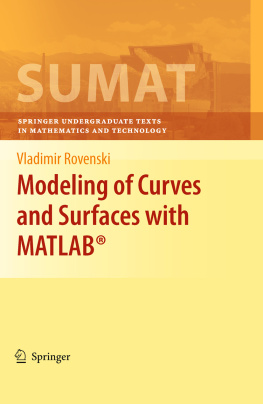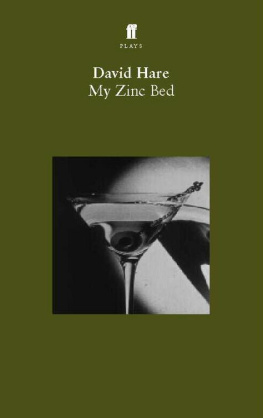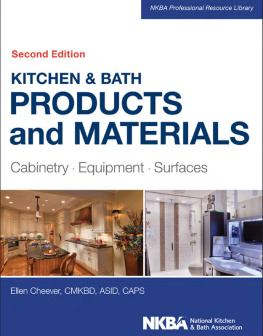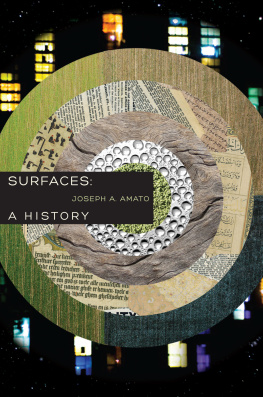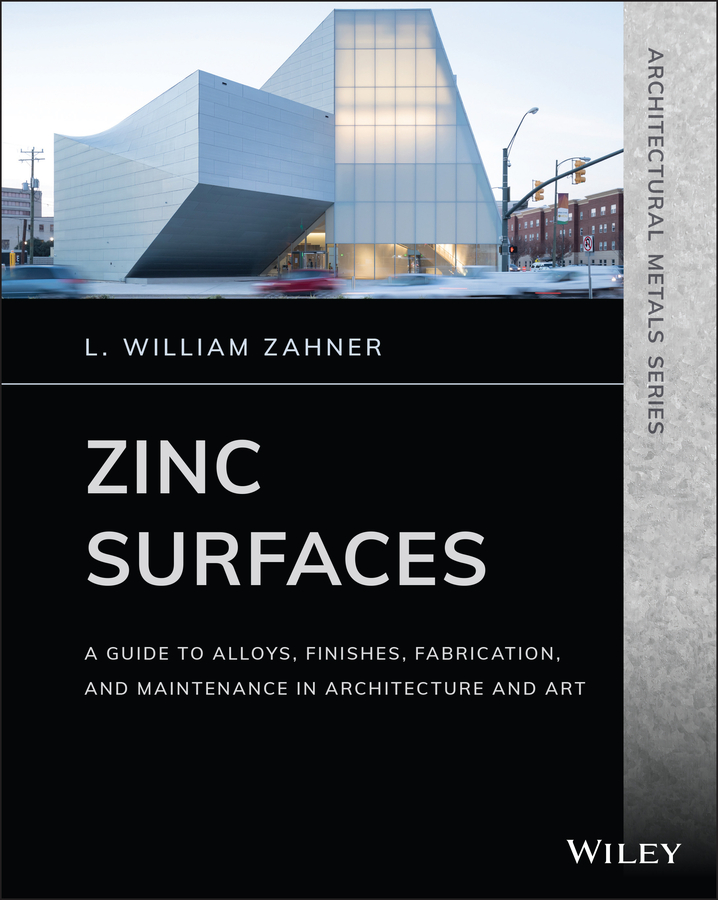
Table of Contents
List of Tables
- Chapter 1
- Chapter 2
- Chapter 3
- Chapter 4
- Chapter 5
- Chapter 6
- Chapter 7
- Chapter 8
List of Illustrations
- Chapter 1
- Chapter 2
- Chapter 3
- Chapter 4
- Chapter 5
- Chapter 6
- Chapter 7
- Chapter 8
Guide
Pages
ZAHNER'S ARCHITECTURAL METALS SERIES
Zahner's Architectural Metals Series offers in-depth coverage of metals used in architecture and art today. Metals in architecture are selected for their durability, strength, and resistance to weather. The metals covered in this series are used extensively in the built environments that make up our world and are also finding appeal and fascination to the artist. These heavily illustrated guides offer comprehensive coverage of how each metal is used in creating surfaces for building exteriors, interiors, and art sculpture. This series provides architects, metal fabricators and developers, design professionals, and students in architecture and design programs with a logical framework for the selection and use of metallic building materials. Forthcoming books in Zahner's Architectural Metals Series will include Copper, Brass, and Bronze; Steel; and Zinc surfaces.
Titles in Zahner's Architectural Metals Series include:
- Stainless Steel Surfaces: A Guide to Alloys, Finishes, Fabrication, and Maintenance in Architecture and Art
- Aluminum Surfaces: A Guide to Alloys, Finishes, Fabrication, and Maintenance in Architecture and Art
- Copper, Brass, and Bronze Surfaces: A Guide to Alloys, Finishes, Fabrication, and Maintenance in Architecture and Art
- Steel Surfaces: A Guide to Alloys, Finishes, Fabrication, and Maintenance in Architecture and Art
- Zinc Surfaces: A Guide to Alloys, Finishes, Fabrication, and Maintenance in Architecture and Art
Zinc Surfaces
A Guide to Alloys, Finishes, Fabrication, and Maintenance in Architecture and Art
L. William Zahner

Copyright 2021 by John Wiley & Sons, Inc. All rights reserved
Published by John Wiley & Sons, Inc., Hoboken, New Jersey
Published simultaneously in Canada
No part of this publication may be reproduced, stored in a retrieval system, or transmitted in any form or by any means, electronic, mechanical, photocopying, recording, scanning, or otherwise, except as permitted under Section 107 or 108 of the 1976 United States Copyright Act, without either the prior written permission of the Publisher, or authorization through payment of the appropriate per-copy fee to the Copyright Clearance Center, 222 Rosewood Drive, Danvers, MA 01923, (978) 750-8400, fax (978) 646-8600, or on the web at www.copyright.com. Requests to the Publisher for permission should be addressed to the Permissions Department, John Wiley & Sons, Inc., 111 River Street, Hoboken, NJ 07030, (201) 748-6011, fax (201) 748-6008, or online at www.wiley.com/go/permissions.
Limit of Liability/Disclaimer of Warranty:
While the publisher and author have used their best efforts in preparing this book, they make no representations or warranties with the respect to the accuracy or completeness of the contents of this book and specifically disclaim any implied warranties of merchantability or fitness for a particular purpose. No warranty may be created or extended by sales representatives or written sales materials. The advice and strategies contained herein may not be suitable for your situation. You should consult with a professional where appropriate. Neither the publisher nor the author shall be liable for damages arising herefrom.
For general information about our other products and services, please contact our Customer Care Department within the United States at (800) 762-2974, outside the United States at (317) 572-3993 or fax (317) 572-4002.
Wiley publishes in a variety of print and electronic formats and by print-on-demand. Some material included with standard print versions of this book may not be included in ebooks or in print-on-demand. If this book refers to media such as a CD or DVD that is not included in the version you purchased, you may download this material at http://booksupport.wiley.com. For more information about Wiley products, visit www.wiley.com.
Library of Congress Cataloging-in-Publication Data
Names: Zahner, L. William, author. | John Wiley & Sons, publisher.
Title: Zinc surfaces: a guide to alloys, finishes, fabrication, and maintenance in architecture and art / L. William Zahner.
Other titles: Zahner's architectural metals series
Description: Hoboken, New Jersey : Wiley, [2021] | Series: Zahner's Architectural Metals Series
Identifiers: LCCN 2021003278 (print) | LCCN 2021003279 (ebook) | ISBN 9781119541615 (paperback) | ISBN 9781119541639 (adobe pdf) | ISBN 9781119541592 (epub)
Subjects: LCSH: ZincSurfaces. | ZincFinishing. | Zinc coatings. | Architectural metal-work. | Art metal-work.
Classification: LCC TS640 .Z34 2021 (print) | LCC TS640 (ebook) | DDC 661/.0661dc23
LC record available at https://lccn.loc.gov/2021003278
LC ebook record available at https://lccn.loc.gov/2021003279
Cover Design: Wiley
Cover Images: (Main) Steven Holl Architects', Institute for Contemporary Art (ICA), Virginia Commonwealth University, photographed by Iwan Bann, c. 2017. (Border) Pattern on zinc plates somnuk / Getty Images
This book is dedicated to my good friend Verne Christensen.
(a designer who proved Alessandro Volta's theory when we built a beautiful curved zinc roof below his copper gutters)
Preface
An expert is an ordinary man who- when he is not home gives advice.
Oscar Wilde
Zinc is the mysterious metal used in art and architecture.
In the United States, it is a paradox. On the one hand, it is considered an Old World metal, used for centuries across Europe. Paris is defined by the roofs of zinc that blanket the city. Yet it is relatively new to North American architecture.
As a metal of art casting or fenestration, little was known until the early 1990s. Sure, we knew of the process of dipping steel in a molten jacket of zinc. Hot-dipped galvanized, a strange fondue for metal, is a process that is well known, but not always understood.
The leading zinc mines that supplied the world were once in the middle of the United States, a region with the town of Joplin, Missouri, as the center. Most zinc mining has ended in the area, but in the late 1800s and early 1900s this was the epicenter of zinc. Millionaires were made by the dozens as the area was tunneled out like a giant anthill.
In North America, the sheet metal industry, art casting industry, and design community knew little about zinc. Publications and training documents throughout the architectural metal industry made no mention of zinc. The old catalogs called the metal white bronze, perhaps attempting to elicit a feeling of noteworthiness by taking on the name bronze. Metal foundries, art schools, and metal workers in the United States lacked any real knowledge of the metal. With the exception of galvanizing, the metal was all but forgotten after the early part of the twentieth century.
When I first started work at Zahner, a 125-year-old metal fabrication company located in the Midwest, zinc was not known as an architectural metal. We did not stock the metal, nor was it specified in any industry publications. We worked with steel, terne, copper, aluminum, stainless steel, and lead, but not zinc. One of the first introductions to the metal occurred during the restoration of the Folly Theater, a turn-of-the-century theater built in 1900. When the workers removed parts of the metal cornice and decorative metal baluster in 1979, they had difficulty determining what the metal was. This metal had lasted 80 years and still looked in good shape. It was silver under the paint, so it was not copper. It was not magnetic so it was not terne-plated steel or galvanized steel. It was heavy, so it wasn't aluminum, and aluminum had not been in common use by 1900. The pieces were spun and assembled in sections by soldering. It was not any metal we were familiar with. It was zinc. From the
Next page


